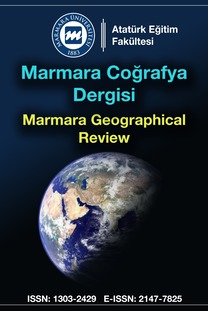Nevşehir’in iklim ve canlı ikliminin turizm açısından değerlendirilmesi
İklim turizm faaliyetleri açısından önemli bir kaynaktır ve turizm tanıtımlarına da dâhil edilmesi gerekmektedir. Bu çalışmada Nevşehir’in iklim ve canlı iklim koşullarının turizm açısından değerlendirilmektedir. Bu koşulların belirlenmesi amacıyla yıl on günlük dönemlere ayrılmış, bu dönemler için fizyolojik eşdeğer sıcaklıklar, ortalama termal algılamalar incelenmiş ve Klimatolojik-Turizm-Bilgilendirme-Şeması oluşturulmuştur. Canlı iklim koşulları yanı sıra hava sıcaklığı, gün ışığı süresi, yağışlı gün sayıları ve yağış miktarı gibi meteorolojik parametrelerin turizm faaliyetleri perspektifinden belirlenmesi insanların kişisel tercihlerine bağlı olarak kendilerine en uygun tatil zamanı belirlemesinde yardımcı olacaktır.
(The Climate and bioclimate of Nevşehir from the perspective of tourism)
Climate is an important resource for tourism and an equally important element that needs to be included in tourism promotions. This study reveals Nevşehir’s bioclimatological conditions. These conditions were identified by using physiologically equivalent temperature and Climate-Tourism- Information-Scheme over 10-day periods and analyzing the mean thermal perception values that emerged. Evaluating bioclimatic conditions and meteorological parameters such as air temperature, duration of sunshine, number of wet days, amount of precipitation and wind, from the perspective of tourism will help people choose the best holiday times depending on their individual needs and circumstances.
___
De Freitas C. R. (1990). Recreation climate assessment. Int J Climatol 10:89–103De Freitas C.R. Matzarakis A. (2005). Recent developments in tourism climatology. Bulletin of the German Meteorological Society 1/ 2005:2–4.
De Freitas, C.R. (2003). Tourism climatology: evaluating environmental information for decision making and business planning in the recreation and tourism sector. Int. J. Biometeorol. 48: 45-54.
Didaskalou E.A, Nastos P, Matzarakis A. (2004). The development prospects of Greek health tourism and the role of the bioclimatic conditions of Greece. Ber Meteor Inst Univ Freiburg 12:149–157
Höppe P. (1999). The physiological equivalent temperature—a universal index for the biometeorological assessment of the thermal environment. Int J Biometeorol 43:71–75.
Lin T. P., Matzarakis A. (2008). Tourism climate and thermal comfort in Sun Moon Lake. Taiwan. Int J Biometeorol 52:281–290
Matzarakis A, Mayer H, Mozes, G.I. (1999). Applications of a universal thermal index: physiological equivalent temperature. Int J Biometeorol 43:76–84
Matzarakis A. (2007). Assessment method for climate and tourism based on daily data. In: Matzarakis A , de Freitas CR, Scott D (Eds) Developments in tourism climatology. German Meteorological Society, pp 52–58
Perry, A. H., 1972, Weather, climate and tourism. Weather 27: 199-203.
TC. Kültür Ve Turizm Bakanlığı Yatırım Ve İşletmeler Genel Müdürlüğü. (2009). Konaklama İstatistikleri (Mahalli İdarelerce Belgelendirilen), Yayın No. 209/2 Ankara.
Zaninović K. (1998). Bioclimatic preferences of Hvar for the development of health tourism (in Croatian). In: Health and tourism. Split/Hvar, pp 63–67.
Zaninović K., (2001). The bioclimatic potential of Croatian Adriatic coast. In: Matzarakis A, de Freitas CR (eds) Proceedings of the First International Workshop on Climate, Tourism and Recreation, pp 257–265.
Zaninović, K., Matzarakis A. (2007). Biometeorological Basis For Tourism, Proceedings of the First International Workshop on Climate, Tourism and Recreation, Matzarakis A, de Freitas CR (eds) s 257–265.
Zaninović, K., Matzarakis A. (2009). The bioclimatological leaflet as a means conveying climatological information to tourists and the tourism industry. Int J Biometeorol, 53:369–374.
- ISSN: 1303-2429
- Yayın Aralığı: Yılda 2 Sayı
- Başlangıç: 1997
- Yayıncı: Marmara Üniversitesi
Sayıdaki Diğer Makaleler
Web haritalama hizmetleri (wms) uygulamalarının teknik ve performans bakımından incelenmesi
ZEKERİYA FATİH İNEÇ, Erdal AKPINAR
Doğa üzerine söylenmiş Türk dünyası ortak atasözlerinin coğrafi analizi (Kıgızistantürkiye örneği)
Türkiye’de lojistik köy uygulamaları ve yeni bir lojistik köy önerisi
VEDAT KARADENİZ, Erdal AKPINAR
Sürdürülebilir turizm kapsamında Burhaniye’nin alternatif turizm potansiyeli
Evliya Çelebiye göre 17. yüzyılda edirne’nin şehir coğrafyası ve kültürel hayat
Mehmet KARAKUYU, Faruk SARIUSTA
Kayadelen karstik Tüneli* (Muş-Varto)
Afyonkarahisar ilinde alternatif tarım çalışmalarına bir örnek: jeotermal seracılık
